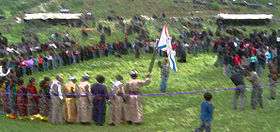Assyrian clothing
| Assyrian people |
|---|
 |
| Culture |
| Music |
| Language |
| Cuisine |
| Folk Dance |
| Religion |
| Clothing |
| Settlements |
Assyrian clothing varies from village to village throughout the Assyrian homeland and beyond.
Dates
The earliest type of costume here is a rather elaborate shawl drapery worn without any tunic underneath. Later comes the tunic with various-fringed shawl draperies worn in addition, and some of the latest types have the tunic worn alone without the shawl draperies. The dates given for the costumes illustrated in this style have been verified at the British Museum. It should be remembered, as in the case of ancient Egyptians costume, that the dresses changed very slowly indeed, and most styles of this era were worn literally for hundreds of years.
Cutting out
The knee-length and full-length tunics with short sleeves are the most common dress worn to different types of headdress. There were essentially only two types of garment generally found in the representations of ancient Assyrian costume: the shawl and the tunic.
These vary in size and proportion, and are worn either alone, but more generally in combination.
Material
The most common material for clothing was wool, although linen had been known from an early period and was often used for better-quality garments. Cotton did not become available until Sennacherib introduced it into Assyria in about 700 BC, from which time it was used for the making of cloth. Other materials sometimes used were leather and papyrus. The skins and furs of animals and metal were also in use, but chiefly for military and hunting costume.
Coloring
Though the actual specimens of these costumes are not possessed, it can still be inferred from the lavish ornament and, from references in the Old Testament writings that rich coloring prevailed. The dyes were probably similar to those of ancient Egypt, and this table will suggest the particular hue of each color:
- Blue: Usually rather dark indigo, sometimes paler.
- Red: Much like the color known as Indian red.
- Yellow: Similar to yellow ochre.
- Green: Much like the paint known as green bice, but rather more dull.
- Purple: Dark, and quite a brownish hue of purple.
All these colors could be used as embroideries on a white or natural colored ground of linen, the embroideries being of wool. In other cases the whole garment might be colored throughout.
Decoration
Except in earliest examples, decoration is lavish in Assyrian costume, in fact, the costume of a king when at its richest may be said to be absolutely covered with ornament. Jewelry, woven and embroidered patterns, and fringes are used in the utmost profusion. Other decorations may include Bracelets, earrings, Various forms of Tassels, Winged globe, Palm tree, Lappet (king's tiara), Vessels, Sword handles, Footwear.
Assyrian characteristics
Some of the Assyrian characteristics may include: The sacred tree, repeated patterns and borders on costumes, various types of rosettes much used in Assyrian decorations. These would be either woven or embroidered.
Differences between male and female clothing
The representations of costume which Assyrian art has left are almost entirely those of men's dress. Two examples of women's dresses are a plain ungirded tunic and a simply draped shawl covering the figure partially. The second is a dress of a Queen, and has the tunic almost entirely covered with a voluminous shawl. The wide belt with narrow belt over it seems to be confined to the men's costume, as also the tighter and scantier shawl draperies, which exist in singular variety.
Gallery
Traditional Assyrian clothing of the men of the Tyari region.
-

Traditional clothing of the Tyari tribe
-
_Christian_family_making_butter%2C_Mawana%2C_Persia.jpg)
Nochiyaye-Assyrian family from Mawana, Iran, in traditional garb
Quotes
- About the national dress worn by the Tiyari men in the Bakuba camp Brigadier-Gen Austin wrote; "Fine upstanding fellows they are, ...their legs, encased in long loose baggy trousers of a greyish hue originally, but so patched all over with bits of blue, red, green and other colors that their pants are veritable patch work. A broad cloth, "Kammar band," or waist band, is folded several times round the trunk of the body, and a short cut-away jacket of amazing colors, worn over a thin cotton variegated shirt. The head-dress consists of conical felt cap as depicted in frescoes of Assyrians of thousands of years ago, and which has survived to this day."[1]
- "There are 115 guests today. Among them are a number of Tyari men, whose wild looks, combined with the splendour of their dress and arms, are of great interest. Their jackets are one mass of gold embroidery, their shirts, with hanging sleeves, are striped satin; their trousers, of sailor cut, are silk, made from the cocoons of their own silkworms, woven with broad crimson stripes on a white ground, on which is a zigzag pattern; and their handsome jackboots are of crimson leather. With their white or red peaked felt hats and twisted silk pagris or head-cloths, their rich girdles, jewelled daggers, and inlaid pistols, they are very imposing." [2]
External links
- http://www.fashion-era.com/ancient_costume/assyrian_clothing_pictures_assur.htm
- http://www.vidoosh.tv/play.php?vid=1646
- http://www.christiansofiraq.com/pict.html
- http://web.archive.org/web/20071103114444/http://www.christiansofiraq.com:80/assyriancostumoc96.html
References
- ↑ Brigadier-Gen. H.H. Austin, "The Baqubah Refugee Camp", The Faith Press, london 1920.
- ↑ Bird, Isabella. "Journeys in Persia and Kurdistan, including a summer in the Upper Karun region and a visit to the Nestorian rayahs". John Murray, London. 1891.